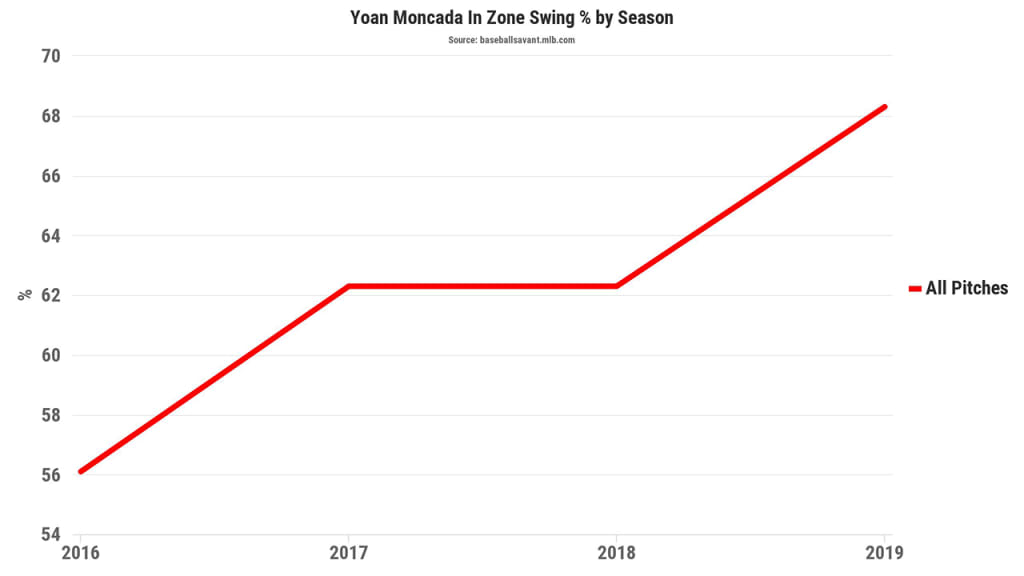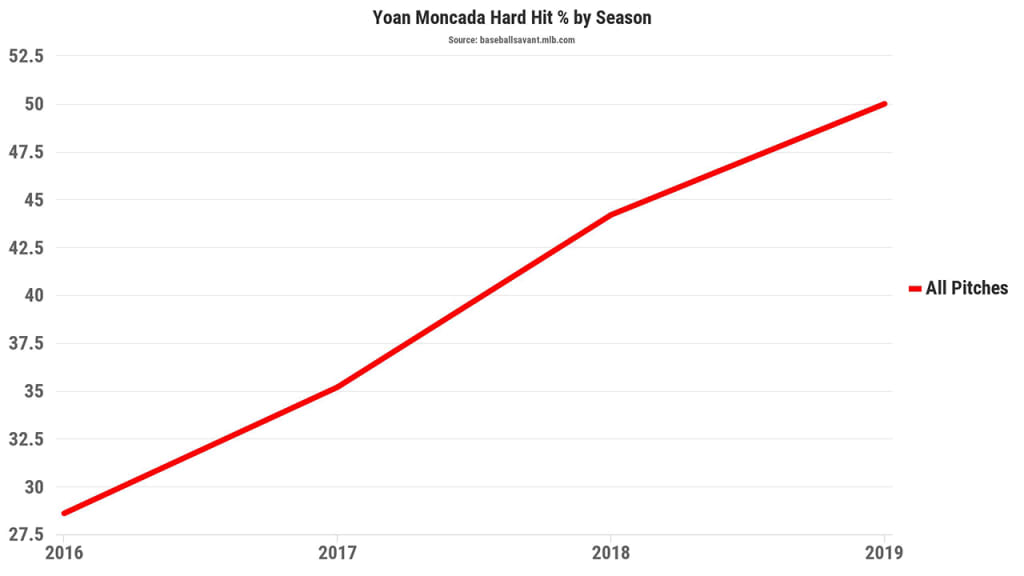A little more than four years ago, Yoan Moncada entered American baseball as one of the most instantly hyped prospects in recent memory. In February 2015, he signed with the Red Sox for a record-smashing $31.5 million bonus that actually cost Boston twice that much, including the penalty for exceeding its bonus pool. He was the No. 8 prospect in baseball at MLB Pipeline in 2015 and No. 1 overall in 2016, then was the headline piece that December in the big Chris Sale trade.
After half a season in 2017 at Triple-A Charlotte, Moncada made his White Sox debut at second base on July 19. The hype train had arrived. Like Ronald Acuña, Cody Bellinger, Juan Soto and other highly regarded prospects of recent vintage, Moncada came up and mashed right away. He was the driving force of the ongoing White Sox rebuild.
In a year and a half of play since then, Moncada has been ... fine. It's been, in some sense, disappointing. He's been a league-average hitter (99 OPS+), though a .234/.321/.403 line in 2017-18 isn't exactly inspiring. He led the Majors with 217 strikeouts in 2018. He's not even a second baseman anymore.
But Moncada is still only 23 years old, at least until the end of May. As MLB.com's David Adler explored in February, there were reasons to think a breakout might be coming. Last September, Moncada hit .301/.369/.398. In Spring Training, he hit .358/.489/.642. In the first 11 games of this season, he's hitting .319/.360/.617.
He's also done this:
And put up Statcast metrics that look like this:
Given the prospect pedigree, the hot start, the youth and just how good he's looked this week, it's time to play our favorite early-April game: Is it real or a small-sample fluke?
There isn't going to be One Satisfying Answer to that question. There rarely is. But we can hopefully get a little closer to knowing just what sort of player the White Sox have on their hands.
Moncada, as we noted, struck out more than any hitter in baseball last season, 217 times. That's so many strikeouts. It's difficult to talk your way around that. But the way in which he made it to that lofty mark was interesting, because it was unusual. Let's explain what made his season notable.
1) So many called strikeouts. Eighty-five of Moncada's strikeouts came looking, not swinging. That wasn't just the most in baseball, it was the most by a huge amount; the second-most was Chris Davis with a mere 56.
2) So many borderline calls. As Adler noted, if you looked at the edges of the strike zone, the area within a baseball's width of the zone boundaries, Moncada had 137 of his total strikeouts (and 60 of his called strikeouts) there. Both were most in the Majors by a large margin.
But when he wasn't striking out, it was interesting how good he could be, because ...
3) Before he got to two strikes, he was fantastic. Last year, when the plate appearance ended before a two-strike count, Moncada was incredible. He hit .400, better than Mookie Betts or Giancarlo Stanton, 20th best of 310 hitters with 100 such plate appearances.
Of course, the flip side of that is ...
4) On two strikes, he was doomed. When the plate appearance ended on a two strike count -- so often, but not always, strikeouts -- Moncada hit a mere .110, 14th worst of 364 hitters with 100 two-strike plate appearances.
The resulting gap between .400 and .110 of 290 points was one the sixth-largest in baseball. (Interestingly, two of the five names ahead of him were J.D. Martinez and Javier Baez.)
That made the problem easy to diagnose, if not easy to solve. Don't get to two strikes. But also, don't get to two strikes being so desperate that you start expanding your zone and flailing at bad pitches.
We know this, because Moncada and the Sox spent a lot of time talking about it.
"As long as he maintains an aggressive approach within the strike zone, which he has been increasing," Chicago manager Rick Renteria said to MLB.com in July, "he has a chance of having really good success obviously."
"We made a plan," Moncada said to MLB.com in December, referring to extensive offseason work with White Sox coaches. "Right now, I am in a better position to succeed and to be a better player next season. It was a very good experience, overall."
“We ended up attacking the topic of his strike-zone approach,” Renteria said. “He has great ability to take pitches. That’s something that’s innate in him.”
So, be more aggressive, but not too aggressive. Is that how it's played out so far? If we can see changes in his approach, maybe we're seeing the beginnings of the hard work paying off; after all, it seems easier to teach a passive hitter to attack than it does to teach an overzealous one to lay off. If not, maybe it's just a hot 10 days or so.
Here's what we know.
He is swinging more inside the zone.

You can ignore that 2016 number, because that was a mere eight games with Boston, but Moncada is indeed being more aggressive inside the zone. That's a good thing, obviously. In his White Sox career, Moncada hits .271 with a .483 slugging inside the zone, and .132 with a .190 slugging outside the zone.
He's more aggressive on those two-strike edge pitches.
Last year, Moncada saw 327 pitches on the edges of the zone with two strikes. He offered at 181 of them, or just over 55 percent, which was well below the Major League average of nearly 75 percent.
Season year -- and we cannot stress the "it's early April" part of this enough -- Moncada has gone after 11 of the 17 two-strike edge pitches, which is 76.5 percent, slightly above the Major League average of 74 percent.
We don't know if this will stick, but he said he wanted to do it, and he's doing it. One of those swings resulted in this absolute rocket, hit at 108.9 mph, in Cleveland on April 3.
He hasn't been called out on strikes even once. Seriously.
Remember, Moncada led the Majors in called strikeouts last year with 85, but that actually undersells it, because it wasn't just the largest number in 2018. It was the largest number in the pitch-tracking era, which goes back to 2008. No one had ever even hit 80 called strikeouts before, with the second-highest number being Davis' 79 in 2016.
That's not a record to be proud of, obviously. But what's fascinating so far is that Moncada has struck out 13 times in 2019 ... and not one has been a called strike. He's gone down against some good pitchers, like Blake Snell, Tyler Glasnow and Charlie Morton (twice apiece) and Mike Clevinger and Yusei Kikuchi. They've all been swinging.
A swinging strikeout isn't better or worse than a called one, obviously. But if you wanted to see more aggressiveness, this is where you look. The record holder for called strikeouts hasn't done it once yet this year.
He's hitting the ball hard more often.
It's not like hitting the ball hard has been a problem, of course. Last year, Moncada's expected batting average on batted balls was in the 74th percentile. His exit velocity was in the 82nd percentile. On contact, good things happen. But when you put the strikeouts back in to those batted balls, his expected batting average was in the sixth percentile, which is very poor.
In his 2017 debut, he had a hard-hit rate of 35.2 percent, roughly league average. In 2018, it was 44.2 percent, solidly above average. In 2019, so far? It's 50 percent, which is currently tied with Baez, Martinez and Miguel Cabrera. It's 29th of the 191 batters with 25 batted balls.

If anything, this is a good reminder that player development isn't linear. Look at Baez, the No. 9 overall prospect in 2013, who hit just .255/.300/.427 (90 OPS+) in parts of four seasons before 2018's breakout. Look at Xander Bogaerts, the No. 6 prospect that year, who hit .283/.339/.409 (100 OPS+) in parts of five seasons before 2018's 135 OPS+ breakout.
It's nice to be Kris Bryant or Corey Seager, top prospects who came up and dominated right away. It doesn't happen for everyone that way. It still might not happen for Moncada. But if you're looking for signs, there are signs. It's more than just the fun early-season line.


